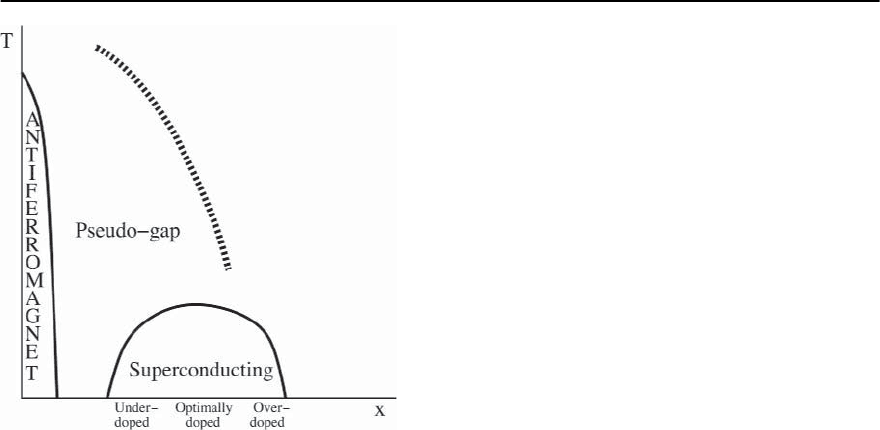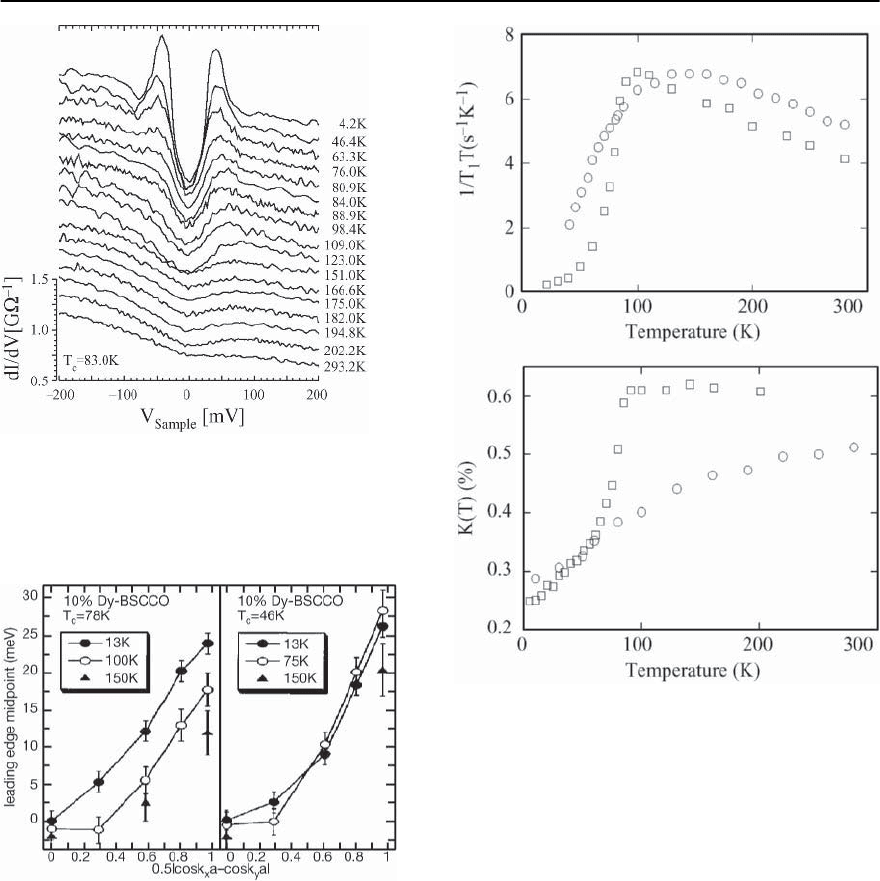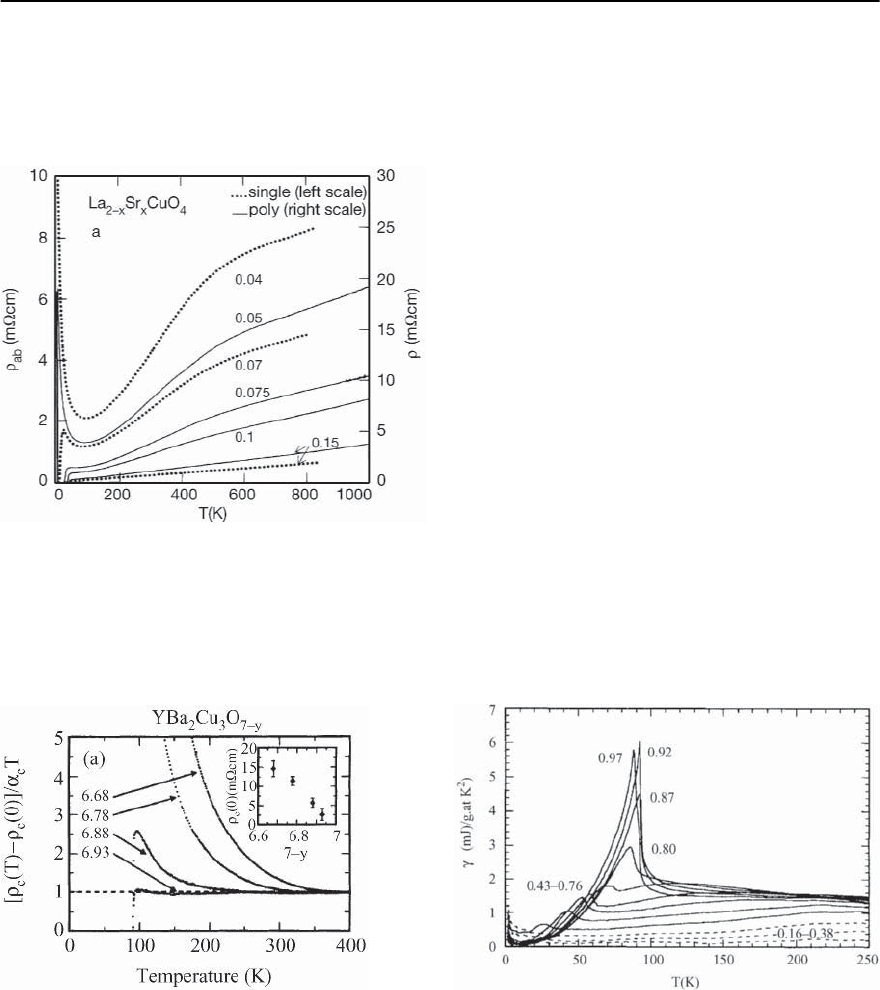Bennemann K.H., Ketterson J.B. Superconductivity: Volume 1: Conventional and Unconventional Superconductors; Volume 2: Novel Superconductors
Подождите немного. Документ загружается.


21 Concepts in High Temperature Superconductivity 1231
by multiplying the interaction strength by the den-
sity of states.We define in an analogous manner for
the electron-phonon interaction. Thus, evenif the in-
stantaneous interaction is repulsive ( i.e. − < 0),
the effective interaction at the scale !
D
will nonethe-
less be attractive ( −
∗
> 0) for !
D
E
F
.Below
this scale,thestandardRG analysis yields the familiar
weak coupling estimate of the pairing scale T
p
:
T
p
∼ !
D
exp[−1/( −
∗
)]. (21.2)
Retarda tion is an essential fea ture of the BCS mecha-
nism.
The essential role of retardation is made clear if one
considers the dependence of T
p
on !
D
:
d log[T
p
]
d log[!
D
]
=1−
∗
log
T
p
!
D
2
. (21.3)
So long as !
D
E
F
exp[−(1 − )/], we have
d log[T
p
]
d log[!
D
]
≈ 1, and T
p
is a linearly rising function
of !
D
, giving rise to the conventional isotope ef-
fect.
4
However, when !
D
> T
p
exp[1/
∗
], we have
d log[T
p
]
d log[!
D
]
< 0, and T
p
becomes a decreasing function
of !
D
! Clearly, unless !
D
is exponentially smaller
than E
F
, superconducting pairing is impossible by
the conventional mechanism.
5
This problem is particularly vexing in the cuprate
high temperature superconductors and similar ma-
terials, which have low electron densities, and in-
cipient or apparent Mott insulating behavior. This
means that screening of the Coulomb interaction is
typically poor, and is thus expected to be large.
Specifically, from the inverse Fourier transform of
the k dependent gap function measured [40] in an-
gle resolved photoemission spectroscopy (ARPES)
on Bi
2
Sr
2
CaCu
2
O
8+ı
,itispossibletoconclude(at
least at the level of the BCS gap equation) that the
dominant pairing interactions have a range equal to
the nearest neighbor copper distance.
Pairing’s Bane
Since this distance is less than the distance between
doped holes, it is difficult to believe that metallic
screening is very effective at these distances. From
cluster calculations and an analysis of various local
spectroscopies, a crude estimate [20] of the Coulomb
repulsion at this distance is of order 0.5 eV or more.
To obtain pairing from a conventional mechanism
with relatively little retardation, it is necessary that
the effective attraction be considerably larger than
this!
We are therefore led to the conclusion that the
only way a BCS mechanism can produce a high pair-
ing scale is if the effective attraction, ,isverylarge
indeed. This, however, brings other problems with it.
21.2.2 Pairing Versus Phase Ordering
In most cases,it is unphysical to assume the existence
of strong attractive interactions between electrons.
However, even supposing we ignore this, strong at-
tractive interactions bring about other problems for
high temperature superconductivity: 1) There is a
concomitant strong reduction of the phase ordering
temperature and thus of T
c
. 2) There is the possibil-
ity of competing orders.We discuss the first problem
here, and the second in Sect. 21.2.3.
Strong attractive interactions typically result in
a large increase in the effective mass, and a corre-
sponding reduction of the phase ordering tempera-
ture. Consider, for example, the strong coupling limit
of the negative U Hubbard model [41] or the Hol-
stein model [42], discussed in Sect. 21.10. In both
cases, pairs have a large binding energy, but they
typically Bose condense at a very low temperature
because of the large effective mass of a tightly bound
pair—the effective mass is proportional to |U|in the
Hubbard model and is exponentially large in the Hol-
stein model (see Sect. 21.10.)
4
Recall, for phonons, d log[!
D
]/d log[M]=−1/2.
5
In the present discussion we have imagined varying !
D
while keeping fixed the electron-phonon coupling constant,
=
C
M!
2
D
=
C
K
,where C is proportional to the (squared) gradient of the electron-ion potential and K is the “spring
constant”between the ions. If we consider instead the effect of increasing !
D
at fixed C/M, it leads to a decrease in
and hence a very rapid suppression of the pairing scale.

1232 E.W. Carlson et al.
Phase ordering is a serious business in the cuprates.
Whereas in conventional superconductors, the bare
superfluid stiffness is so great that even a substantial
renormalization of the effective mass would hardly
matter, in the cuprate high temperature supercon-
ductors, the superfluid stiffness is small, and a sub-
stantial mass renormalization would be catastrophic.
Thepointcanbemademostsimplybyconsidering
the result of simple dimensional analysis. The den-
sity of doped holes per plane in an optimally doped
high temperature superconductor is approximately
n
2d
=10
14
cm
−2
. Assuming a density of hole pairs
that is half this, and taking the rough estimate for
the pair effective mass, m
∗
=2m
e
, we find a phase
ordering scale,
T
=
2
n
2d
/2m
∗
≈ 10
−2
eV ≈ 100 K . (21.4)
Since this is in the neighborhood of the actual T
c
,
it clearly implies that any large mass renormaliza-
tion would be incompatible with a high transition
temperature.What about conventional superconduc-
tors? A similar estimate in a W = 10 Å thick Pb film
givesT
=
2
n
3d
W/2m
∗
≈ 1eV ≈ 10, 000 K! Clearly,
phase fluctuations are unimportant in Pb. This issue
is addressed in detail in Sect. 21.8.
A general principle is proposed: “optimal” T
c
occurs
as a crossover.
We have seen how T
p
and T
have opposite depen-
dence on coupling strength. If this is a general trend,
then it is likelythat anymaterial in whichT
c
has been
optimized has effectively been tuned to a crossover
point between pairing and condensation. A modifi-
cation of the material which produces stronger ef-
fective interactions will increase phase fluctuations
and thereby reduce T
c
,while weaker interactions will
lower T
c
because of pair breaking. In Sect. 21.8 it
will be shown that optimal doping in the cuprate su-
perconductors corresponds to precisely this sort of
crossover from a regime in which T
c
is determined
by phase ordering to a pairing dominated regime.
21.2.3 Competing Orders
A Fermi liquid is a remarkably robust state of mat-
ter. In the absence of nesting, it is stable for a range
6
of repulsive interactions; the Cooper instability is its
only weak coupling instability. Thephase diagram of
simple metals consists of a high temperature metallic
phase and a low temperature superconducting state.
When the superconductivity is suppressed by either
a magnetic field or appropriate disorder ( e.g. para-
magnetic impurities), the system remains metallic
down to the lowest temperatures.
The situation becomes considerably more com-
plex for sufficiently strong interactions between elec-
trons. In this case, the Fermi liquid description of
the normal or high temperature phase breaks down
7
and many possible phases compete. In addition to
metallic and superconducting phases, one would
generally expect various sorts of electronic “crys-
talline”phases, including charge ordered phases ( i.e.
a charge density wave (CDW) of which the Wigner
crystal is the simplest example) and spin ordered
phases (i.e. a spin density wave (SDW) of which the
N´eel state is the simplest example).
Typically, one thinks of such phases as insulating,
but it is certainly possible for charge and spin or-
der to coexist with metallic or even superconducting
electron transport. For example, this can occur in
a conventional weak coupling theory if the density
wave order opens a gap on only part of the Fermi
surface, leaving other parts gapless [43]. It can also
occur in a multicomponent system,in which the den-
sity wave order involves one set of electronic orbitals,
and the conduction occurs through others—this is
the traditional understanding of the coexisting su-
perconducting and magnetic order in the Chevrel
compounds [44].
“Stripe” order
Such coexistence is also possible for less conven-
tional orders. One particular class of competing or-
ders is known loosely as “stripe” order. Stripe order
refers to unidirectional density wave order, i.e.order
which spontaneously breaks translational symmetry
6
As long as the interactions are not too strong.
7
Whether it breaks down for fundamental or practical reasons is unimportant.

21 Concepts in High Temperature Superconductivity 1233
in one direction but not in others. We will refer to
charge stripe order, if the broken symmetry leads to
charge density modulations and spin stripe order if
the broken symmetry leads to spin density modula-
tions, as well. Charge stripe order can occur without
spin order, but spin order (in a sense that will be
made precise,below) implies charge order [45].Both
are known on theoretical and experimental grounds
to be a prominent feature of doped Mott insulators
in general, and the high temperature superconduc-
tors in particular [6,46–51].Each of these orders can
occur in an insulating, metallic, or superconducting
state.
In recent years there has been considerable the-
oretical interest in other types of order that could
be induced by strong interactions. From the perspec-
tive of stripe phases, it is natural to consider various
partially melted “stripe liquid” phases, and to clas-
sify such phases, in analogy with the classification of
phases of classical liquid crystals, according to their
broken symmetries [52]. For instance, one can imag-
ine a phase that breaks rotational symmetry (or, in a
crystal, the point group symmetry) but not transla-
tional symmetry, i.e. quantum (ground state) ana-
logues of nematic or hexatic liquidcrystalline phases.
Still more exotic phases, such as those with ground
state orbital currents [53–58] or topological order
[59], have also been suggested as the explanation for
various observed features of the phenomenology of
the high temperature superconductors.
Competition matters. . .
Given the complex character of the phase diagram of
highly correlatedelectrons,it is clear thatthe conven-
tional approach to superconductivity,which focuses
solely on the properties of the normal metal and
the pure superconducting phase, is suspect. A more
global approach, which takes into account some (or
all) of the competing phases is called for. Moreover,
even the term “competing” carries with it a preju-
dice that must not be accepted without thought. In a
weakly correlated system, in which any low temper-
ature ordered state occurs as a Fermi surface insta-
bility, different orders generally do compete: if one
order produces a gap on part of the Fermi surface,
there are fewer remaining low energy degrees of free-
dom to participate in the formation of another type
of order.
...andsodoessymbiosis.
For highly correlated electrons, however, the sign of
the interaction between different types of order is
less clear. It can happen [60] that under one set of
circumstances, a given order tends to enhance su-
perconductivity and under others, to suppress it.
The issue of competing orders, of course, is not
new. In a Fermi liquid, strong effective attractions
typically lead to lattice instabilities, charge or spin
density wave order, etc. Here the problem is that the
system either becomes an insulator or, if it remains
metallic,the residual attraction is typically weak.For
instance,lattice instability has been seen to limit the
superconducting transition temperature of the A15
compounds, the high temperature superconductors
of a previous generation. Indeed, the previous gen-
eration of BCS based theories which addressed the
issue always concluded that competing orders sup-
press superconductivity [44].
More recently it has been argued that near an
instability to an ordered state there is a low lying
collective mode (the incipient Goldstone mode of
the ordered phase) which can play the role of the
phonon in a BCS-likemechanism of superconductiv-
ity [29,61,62].Inan interesting variant of this idea, it
has been argued that in the neighborhood of a zero
temperature transition to an ordered phase, quan-
tum critical fluctuations can mediate superconduct-
ing pairing in a more or less traditional way [63–65].
There are reasons to expect this type of fluctuation
mediated pair binding to lead to a depression of T
c
.
If the collective modes are nearly Goldstone modes
(as opposed to relaxational “critical modes”), gen-
eral considerations governing the couplings of such
modes in the ordered phase imply that the supercon-
ducting transition temperature is depressedsubstan-
tially from any naive estimate by large vertex correc-
tions [66]. Moreover,ina regime of large fluctuations
to a nearby ordered phase, one generally expects a
density of states reduction due to the development
of a pseudogap; feeding this pseudogapped density
of states back into the BCS-Eliashberg theory will
again result in a significant reduction of T
c
.

1234 E.W. Carlson et al.
21.3 Superconductivity in the Cuprates:
General Considerations
While the principal focus of the present article is
theoretical, the choice of topics and models and the
approaches are very much motivated by our inter-
est in the experimentally observed properties of the
cuprate high temperature superconductors. In this
section, we discuss briefly some of the most dramatic
(and least controversial) aspects of the phenomenol-
ogy of these materials,and what sorts of constraints
those observations imply for theory. As we are pri-
marily interested in the origin of high temperature
superconductivity, we will deal here almost exclu-
sively with experiments in the temperature and en-
ergy ranges between about T
c
/2andafewtimesT
c
.
Before starting, there are a number of descrip-
tive terms that warrant definition. The parent state
of each family of the high temperature superconduc-
tors is an antiferromagnetic “Mott” insulator with
onehole(andspin1/2) per planar copper.
8
These
insulators are transformed into superconductors by
introducing a concentration, x,of“dopedholes”into
the copper oxide planes. As a function of increas-
ing x, the antiferromagnetic transition temperature
is rapidly suppressed to zero,then the superconduct-
ing transition temperature rises from zero to a max-
imum and then drops down again (see Fig. 21.1).
Where T
c
is an increasing function of x,themateri-
als are said to be “underdoped.” They are “optimally
doped” where T
c
reaches its maximum at x ≈ 0.15,
and they are “overdoped” for larger x.Intheunder-
doped regime there are a variety of crossover phe-
nomena observed [81,82] at temperatures above T
c
in which various forms of spectral weight at low en-
ergies are apparently suppressed—these phenomena
are associated with the opening of a “psuedogap.”
There are various families of high temperature su-
perconductors, all of which have the same nearly
square copper oxide planes, but different structures
in the regions between the planes. One characteristic
that seems to have a fairly direct connection with T
c
is the number of copper-oxide planes that are close
enough to each other that interplanecoupling may be
significant; T
c
seems generally to increase with num-
ber of planes within a homologous series, at least as
one progresses from“single layer”to“bilayer,”to“tri-
layer”materials [4,83].
21.3.1 A Fermi Surface Inst ability Requires a Fermi
Surface
As has been stressed, for instance, by Schrieffer [1],
BCS theory relies heavily on the accuracy with which
the normal state is described by Fermi liquid theory.
BCS superconductivity is a Fermi surface instabil-
ity, which is only a reasonable concept if there is a
well defined Fermi surface. BCS-Eliashberg theory
relies on the dominance of a certain class of dia-
grams, summed to all orders in perturbation theory.
8
The term “Mott insulator” means many things to many people. One definition is that a Mott insulator is insulating
because of interactions between electrons, rather than because a noninteracting band is filled. This is not a precise
definition. For example, a Mott insulating state can arise due to a spontaneously broken symmetry which increases
the size of the unit cell. However, this is adiabatically connected to the weak coupling limit, and can be qualitatively
understood via generalized Hartree–Fock theory. There is still a quantitative distinction between a weak coupling
“simple” insulator on the one hand, which has an insulating gap that is directly related to the order parameter which
characterizes the broken symmetry, and the “Mott” insulator on the other hand, which has an insulating gap which is
large due to the strong repulsion between electrons.In the latter case,the resistivity begins togrow very large compared
to the quantum of resistance well above the temperature at which the broken symmetry occurs. The undoped cuprate
superconductors are clearly Mott insulators in the quantitative sense that the insulating gap is of order 2eV, while the
antiferromagnetic ordering temperatures are around 30 meV.
However, for those who prefer [67] a sharp,qualitative distinction,the term“Mott insulator”is reserved for“spin liquid”
states which are distinct zero temperature phases of matter, do not break symmetries, and cannot be understood in
terms of any straightforward Hartree–Fock description. Many such exotic states have been theoretically envisaged,
including the long [5,68] and short ranged [69–71] RVB liquids, the chiral spin liquid [72–74], the nodal spin liq-
uid [75, 76] and various other fractionalized states with topological order [77,78]. Very recently, in the first “proof of
principle,” a concrete model with a well defined short ranged RVB phase has been discovered [79,80].

21 Concepts in High Temperature Superconductivity 1235
Fig. 21.1. Schematic phase diagram of a cuprate high tem-
perature superconductor as a function of temperature and
x—the density of doped holes per planar Cu. The solid
lines represent phase transitions into the antiferromag-
netic (AF) and superconducting (SC) states. The dashed
line marks the openning of a pseudogap (PG). The latter
crossover is not sharply defined and there is still debate on
its position; see [81,82]
This can be justifiedfrom phase space considerations
for a Fermi liquid,but need not be valid more gener-
ally. To put it most physically, BCS theory pairs well
defined quasiparticles, and therefore requires well
defined quasiparticles in the normal state.
We belabor the need for a non-Fermi liquid based ap-
proach.
There is ample evidence that in optimally and un-
derdoped cuprates, at least, there are no well de-
fined quasiparticles in the normal state. This can
be deduced directly from ARPES studies of the sin-
gle particle spectral function [84–91], or indirectly
from an analysis of various spin, current, and den-
sity response functions of the system [3, 4]. (Many,
though not all, of these response functions have
been successfully described [92–94] by the“marginal
Fermi liquid” phenomenology.) Because we under-
stand the nature of a Fermi liquid so well, it is rel-
atively straightforward to establish that a system is
a non-Fermi liquid, at least in extreme cases. It is
much harder to establish the cause of this behavior—
it could be due to the proximity of a fundamentally
new non-Fermi liquid ground state phase of matter,
or it could be because the characteristic coherence
temperature, below which well defined quasiparti-
cles dominate the physics, is lower than the temper-
atures of interest. Regardless of the reason for the
breakdown of Fermi liquid theory, a description of
the physics at scales of temperatures comparable to
T
c
can clearly not be based on a quasiparticle de-
scription, and thus cannot rely on BCS theory.
21.3.2 There is No Room for Retardation
As stressed in Sect. 21.2.1, retardation plays a pivotal
role in the BCS mechanism. In the typical metal-
lic superconductor, the Fermi energy is of order
10eV, while phonon frequencies are of order 10
−2
eV,
so E
F
/!
D
∼ 10
3
! Since the renormalization of the
Coulomb pseudopotential is logarithmic, this large
value of the retardation is needed. In the cuprate su-
perconductors, the bandwidth measured in ARPES is
roughly E
F
≈ 0.3eV—this is a renormalized band-
width of sorts, but this is presumably what deter-
mines the quasiparticle dynamics. Independent of
anything else,theinduced interaction must clearly be
fast compared to the gap scale, !
D
> 2
0
,where
0
is the magnitude of the superconducting gap. From
either ARPES [95,96] or tunneling [97] experiments,
we can estimate 2
0
≈ 0.06eV. Thus, a rough up-
per bound E
F
/!
D
< E
F
/2
0
∼ 5canbeestablished
on how retarded an interaction in the cuprates can
possibly be. That is almost not retarded at all!
21.3.3 Pairing is Collective!
For the most part, the superconducting coherence
length,
0
, cannot be directly measured in the high
temperature superconductors because, for T T
c
,
the upper criticalfield,H
c2
,istoo high to access read-
ily. However, it can be inferred indirectly [98–102]
in various ways, and for the most part people have
concluded that
0
is approximately 2 or 3 lattice con-
stants in typical optimally doped materials. This has
lead many people to conclude that these materials
are nearly in a“real space pairing”limit [103–107],in

1236 E.W. Carlson et al.
which pairs of holes form actual two particle bound
states, and then Bose condense at T
c
.Thisnotion
is based on the observation that if x is the density
of “doped holes” per site, then the number of pairs
per coherence area, N
p
=(1/2)x
2
0
/a
2
,isanum-
ber which is approximately equal to 1 for “optimal
doping,” x ≈ 0.15 − 0.20.
Real space pairs are dismissed.
However,there are strong a priori and empirical rea-
sons to discard this viewpoint.
On theoretical grounds: In a system dominated by
strong repulsive interactions between electrons, it is
clear that pairing must be a collective phenomenon.
The Coulomb interaction between an isolated pair
of doped holes would seem to be prohibitively large,
and it seems unlikely that a strong enough effective
attraction can emerge to make such a strong bind-
ing possible. (Some numerical studies of this have
been carried out, in the context of ladder systems,
by Dagotto and collaborators [108].) Moreover, it is
far from clear that the dimensional argument used
above makes any sense: Why should we only count
doped holes in making this estimate? What are the
rest of the holes doing all this time? If we use the
density of holes per site (1 + x), which is consistent
with the area enclosed by the Fermi surface seen in
ARPES [109], the resulting N
p
is an order of mag-
nitude larger than the above estimate. A theory of
real space pairs which includes all the electrons and
the repulsive interactions between them can be car-
icatured as a hard core quantum dimer model [70].
Here the pairing is collective, due to the high density
of pairs. Indeed, N
p
involves all of the electrons (the
doped holes are not paired at all), but the superfluid
density is small, involving only the density of doped
holes. This contrasts markedly with the case of clean
metallic superconductors where the density of pairs
(that is, the density of electrons whose state is sig-
nificantly altered by pairing) is small, ∼ N(E
F
)
0
,
while the superfluid density is large and involves all
the electrons. There is some evidence that the former
situation in fact pertains to the high temperature su-
perconductors [110].
On experimental grounds: The essential defining
feature of real space pairing is that the chemical po-
tential moves below the bottom of the band.Incipient
real space pairing must thus be associated with sig-
nificant motion of the chemical potential toward the
band bottom with pairing [103,104,111,112]. How-
ever, experimentally, the chemical potential is found
to lie in the middle of the band, where the enclosed
area of the Brillouin zone satisfies Luttinger’s the-
orem, and no significant motion at T
c
(or at any
pseudogap temperature in underdoped materials)
has been observed [113–116]. This fact, alone, estab-
lishes that the physics is nowhere near the real space
pairing limit. A rather larger value of the chemical
potential shift at T
c
, but still very small compared
to the bandwidth, was obtained from high precision
measurements of the work function [117].
21.3.4 What Determines the Symmetry of the Pair
Wavefunction?
Theory has had its t riumphs.
Independent of but contemporary with the discov-
ery of high temperature superconductivity in the
cuprates, Scalapino, Loh, and Hirsch [118], in a pre-
scient work suggested the possibility of supercon-
ductivity in the two-dimensional Hubbard model in
the neighborhood of the antiferromagnetic state at
half filling. This work, which was in spirit a real-
ization of the ideas of Kohn and Luttinger [119],
concluded that the dominant superconducting in-
stability should have d
(x
2
−y
2
)
symmetry, as opposed
to s symmetry. Immediately after the discovery of
high temperature superconductivity, a large number
of other theorists [29,120–125] came to the same
conclusion, based on a variety of purely theoretical
analyses, although at the time the experimental ev-
idence of such pairing was ambiguous, at best. By
now it seems very clear that this idea was correct,
at least for a majority of the cuprate superconduc-
tors, based on a variety of phase sensitive measure-
ments [126–128]. This represents one of the great
triumphs of theory in this field.(There are still some
experiments which appear to contradict this symme-
try assignment [129],so the subject cannot be said to
be completely closed, but it seems very unlikely that
the basic conclusion will be overturned.)

21 Concepts in High Temperature Superconductivity 1237
d-wave pairing is defined.
While the names “s”and“d”relatetotherotational
symmetries of free space, it is important to under-
stand what is meant by s-wave and d-wavein a lattice
system which,in place of continuousrotational sym-
metry, has the discrete point group symmetry of the
crystal. Consequently, the possible pairing symme-
tries correspond to the irreducible representations
of the point group: singlet orders are even under in-
version and triplet orders are odd. In the case of a
square crystal,
9
the possible singlet orders (all cor-
responding to one-dimensional representations) are
colloquially called s, d
(x
2
−y
2
)
, d
(xy)
,andg,andtrans-
form like 1, (x
2
− y
2
), (xy), and (x
2
− y
2
)(xy), respec-
tively. As a function of angle, the gap parameter in
an s-waveorder always has a uniquesign,the d-wave
gap changes sign four times, and the g-wave changes
sign 8 times. A fifth type of order is sometimes dis-
cussed, called extended-s,inwhichthegapfunction
changes sign as a function of the magnitude of k,
rather than as a function of its direction—this is not
a true symmetry classification, and in any generic
model there is always finite mixing between s and
extended s.
“d-wave-like” pa iring is defined.
In crystals with lowersymmetry,there are fewer truly
distinct irreducible representations. For instance, if
the square lattice is replaced with a rectangular one,
the distinction between s and d
(x
2
−y
2
)
is lost (they
mix),asis that between d
(xy)
andg.On the other hand,
if the elementary squares are sheared to form rhom-
buses, then the s and d
(xy)
symmetries are mixed,
as are d
(x
2
−y
2
)
,andg. Both of these lower symme-
tries correspond to a form of orthorhombic distor-
tion observed in the cuprates—the former is the cor-
rect symmetry group for YBa
2
Cu
3
O
7−ı
and the latter
for La
2−x
Sr
x
CuO
4
. However, so long as the physics
does not change fundamentally as the lattice sym-
metry is reduced, it is reasonable to classify order
parameters as “d-wave-like”or“s-wave-like.” We de-
fine an order parameter as being d-wave-like if it
changes sign under 90
o
rotation, although it is only
atrued-waveifitsmagnitudeisinvariantunder
this transformation. Conversely, it is s-wave-like if
itssigndoesnotchangeunderthisrotation,orwhen
reflected through any approximate symmetry plane.
In almost all cases what is really being seen in phase
sensitive measurements on the cuprates is that the
order parameter is d-wave-like. (It is worth noting
that in t − J and Hubbard ladders, d-wave-like pair-
ing is the dominant formof pairing observed in both
analytic and numerical studies, as discussed below.)
Strong repulsion does not necessarily lead to d-wa ve
pairing.
There is a widespread belief that d-wave symmetry
follows directly from the presence of strong short
range interactions between electrons, irrespective of
detailssuchasbandstructure.Theessentialideahere
follows from the observation that the pair wavefunc-
tion, at the level of BCS mean field theory, is ex-
pressed in terms of the gap parameter,
k
, and the
quasiparticle spectrum, E
k
,as
pair
(r)=
k
1
L
d/2
e
ik·r
k
2E
k
. (21.5)
In the presence of strong short range repulsion (and
weaker longer range attraction) between electrons,
it is favorable for
pair
to vanish at r = 0,whichit
does automatically if the pairing is not s-wave.While
this argument makes some physical sense, it is ulti-
mately wrong. In the limit of dilute electrons, where
the coherence length is much smaller than the inter-
electron distance, the pairing problem reduces to a
two particle problem. It is well known that in the
continuum the lowest energy two particle spin sin-
glet bound state is nodeless. Given certain mild con-
ditions on the band structure one can also prove it
on the lattice.
10
Therefore, in this limit, the order pa-
rameter is necessarily s-wave-like!
The above discrepancy teaches us that it is the
presence of the kinematical constraints imposed by
9
The pairing symmetries should really be classified according to the point group of a tetragonal crystal, but since the
cuprates are quasi-two-dimensional, it is conventional, and probably reasonable, to classify them according to the
symmetries of a square lattice.
10
This is true under conditions that the hopping matrix, i.e. the band structure, satisfies a Peron–Frobenius condition.

1238 E.W. Carlson et al.
the Fermi sea that allows for non s-wave pairing.
The ultimate pairing symmetry is a reflection of the
distribution in momentum space of the low energy
single particle spectral weight. The reason for this
is clear within BCS theory where the energy gain,
which drives the transition,comes from the interac-
tion term
potential energy =
k,k
V
k,k
k
2E
k
k
2E
k
, (21.6)
which is maximized by a gap function that peaks in
regions of high density of states unless the pairing
potential that connects these regions is particularly
small. (Although we do not know of an explicit jus-
tification of this argument for a non-BCS theory, for
example one which is driven by gain in kinetic en-
ergy, we feel that the physical consideration behind
it is robust.)
Nodal quasiparticles do not a d-wave mean.
Finally, there is another issue which is related to or-
der parameter symmetry in a manner that is more
complex than is usually thought—this is the issue
of the existence of nodal quasiparticles. While nodal
quasiparticles are natural in a d-wave superconduc-
tor, d-wave superconductors can be nodeless, and s-
wave superconductors can be nodal. To see this, it is
possible to work entirely in the weak coupling limit
where BCS theory is reliable. The quasiparticle exci-
tation spectrum can thus be expressed as
E
k
=
"
2
k
+
2
k
, (21.7)
where "
k
is the quasiparticle dispersion in the nor-
mal state (measured from the Fermi energy). Nodal
quasiparticles occur wherever the Fermi surface,that
is the locus of points where "
k
= 0, crosses a line of
gap nodes, the locus of points where
k
=0.Ifthe
Fermi surface is closed around the origin, k =0,or
about the Brillouin zone center, k =(, )(asit
is most likely in optimally doped Bi
2
Sr
2
CaCu
2
O
8+ı
[130]), then the d-wave symmetry of
k
= 0 implies
the existence of nodes. However,if the Fermi surface
were closed about k =(0, ) (and symmetry related
points),therewould be no nodalquasiparticles[131].
Indeed, it is relatively easy to characterize [132,133]
the quantum phase transition between a nodal and
nodeless d-wave superconductor which occurs as a
parameter that alters the underlying band structure
is varied. Conversely, it is possible to have lines of
gap nodes for an extended s-wave superconductor,
and if these cross the Fermi surface, the supercon-
ductor will posses nodal quasiparticles.
21.3.5 What Does the Pseudogap Mean?
What Experiments Define the Pseudogap?
The pseudogap.
One of the most prominent, and most discussed
features of the cuprate superconductors is a set of
crossover phenomena [54, 81,82] which are widely
observed in underdoped cuprates and, to various ex-
tents,in optimally and even slightly overdoped mate-
rials.Among the experimental probes which are used
to locate the pseudogap temperature in different ma-
terials are:
1) ARPES and c-axis Tunnelling:
There is a suppression of the low energy single par-
ticle spectral weight, shown in Figs. 21.2 and 21.3
at temperatures above T
c
as detected, primarily, in
c-axis tunneling [134] and ARPES [95, 96] experi-
ments. The scale of energies and the momentum de-
pendence of this suppression are very reminiscent
of the d-wave superconducting gap observed in the
same materials at temperatures well below T
c
.This
is highly suggestive of an identification between the
pseudogap and some form of local superconducting
pairing. Although a pseudogap energy scale is easily
deduced from these experiments, it is not so clear
to us that an unambiguous temperature scale can be
cleanly obtained from them. (The c-axis here, and
henceforth, refers to the direction perpendicular to
the copper-oxide planes, which are also referred to,
crystallographically, as the ab plane.)
2) Cu NMR:
There is a suppression of low energy spin fluctua-
tionsas detected[135] primarily in Cu NMR.In some
cases, two rather different temperature scales are de-
duced from these experiments: an upper crossover
temperature, at which a peak occurs in
,thereal
part of the uniform spin susceptibility ( i.e. the

21 Concepts in High Temperature Superconductivity 1239
Fig. 21.2. Tunneling density of states in a sample of un-
derdoped Bi
2
Sr
2
CaCu
2
O
8+ı
(T
c
=83K)asafunctionof
temperature. Note that there is no tendency for the gap to
closeas T
c
is approachedfrom below,but thatthe sharp“co-
herence peaks” in the spectrum do vanish at T
c
. From [97]
Fig. 21.3. The angular dependence of the gap in
the normal and superconducting states of underdoped
Bi
2
Sr
2
Ca
1−x
Dy
x
Cu
2
O
8+ı
as deduced from the leading edge
energy of the single hole spectral function A
<
(k, !)mea-
sured by ARPES. A straight line in this plot would cor-
respond to the simplest d
x
2
−y
2 gap, |
k
| =
0
|cos(k
x
)−
cos(k
y
)|. From [95]
Knight shift), and a lower crossover temperature, be-
low which 1/T
1
T drops precipitously (see Fig. 21.4).
Note that 1/T
1
T ∝ lim
!→0
dkf (k)
(k, !)/!,the
Fig. 21.4. Temperature dependence of the planar
63
Cu re-
laxation rate 1/T
1
T and Knight shift K in optimally doped
YBa
2
Cu
3
O
6.95
(squares)andunderdopedYBa
2
Cu
3
O
6.64
(cir-
cles). From [81]
k averaged density of states for magnetic excitations,
where f (k) is an appropriate form factor which re-
flects the local hyperfine coupling.Although the tem-
perature scale deduced from
is more or less in ac-
cordance with the pseudogap scale deduced from a
number of other spectroscopies, it is actually a mea-
sure of the reactive response of the spin system. The
notionof a gap can be more directlyidentified with a
feature in
.(A note of warning: while the structure
in 1/T
1
T can be fairly sharp at times, the observed
maxima in
are always very broad and do not yield
a sharply defined temperature scale without further
analysis.)

1240 E.W. Carlson et al.
3) Resistiv ity:
There is a significant deviation [136,137] of the re-
sistivity in the ab plane from the T linear temper-
ature dependence which is universally observed at
high temperatures.A pseudogap temperature is then
Fig. 21.5. The temperature dependence of the longi-
tudinal resistivity in underdoped and optimally doped
La
2−x
Sr
x
CuO
4
.Thedotted lines correspond to the in-plane
resistivity (
ab
) of single crystal films while the solid lines
depict the resistivity () of polycrystalline samples. The
doping levels are indicated next to the curves. From [136]
Fig. 21.6. The temperature dependence of the c-axis resis-
tivity in underdoped and optimally doped YBa
2
Cu
3
O
7−ı
.
Here ˛
c
and
c
(0) are the slope and the intercept, respec-
tively, when the metalic part of
c
is approximated by a
linear-T behavior. The inset shows how
c
(0) varies with
oxygen content. From [138]
identified as the point below which d
xx
/dT deviates
(increases) significantly from its high temperature
value (see Fig. 21.5). In some cases,a similar temper-
ature scale can be inferred from a scaling analysis of
the Hall resistance, as well.
The pseudogap also appearsin the c-axis resitivity,
although in a somewhat different manner [138,139].
Inthis direction,thepseudogap results in a strong in-
crease in the resistivity, reminiscent of the behavior
of a narrow gap semiconductor,as shown in Fig. 21.6.
If we imagine that the c-axis transport is dominated
by tunneling events between neighboringplanes,it is
reasonable that a bulk measurement of
c
will reflect
the pseudogap in much the same way as the c-axis
tunneling does.
4) Specific Heat:
There is a suppression of the expected electronic
specific heat [82]. Above the pseudogap scale, the
specific heat is generally found to be linear in tem-
perature, C
V
≈ T, but below the pseudogap tem-
perature, C
V
/T begins to decrease with decreasing
temperature (see Fig. 21.7). Interestingly, since the
value of above the pseudogap temperature ap-
pears to be roughly doping independent, the drop
in the specific at lower temperatures can be in-
terpreted as a doping dependent loss of entropy,
Fig. 21.7. Thermal density of “electronic” states, ≡ C
V
/T
as a function of temperature for various oxygen concen-
trations in underdoped YBa
2
Cu
3
O
6+x
. From [140]. As dis-
cussed in [140], a complicated proceedure has been used
to subtract the large nonelectronic component of the mea-
sured specific heat
